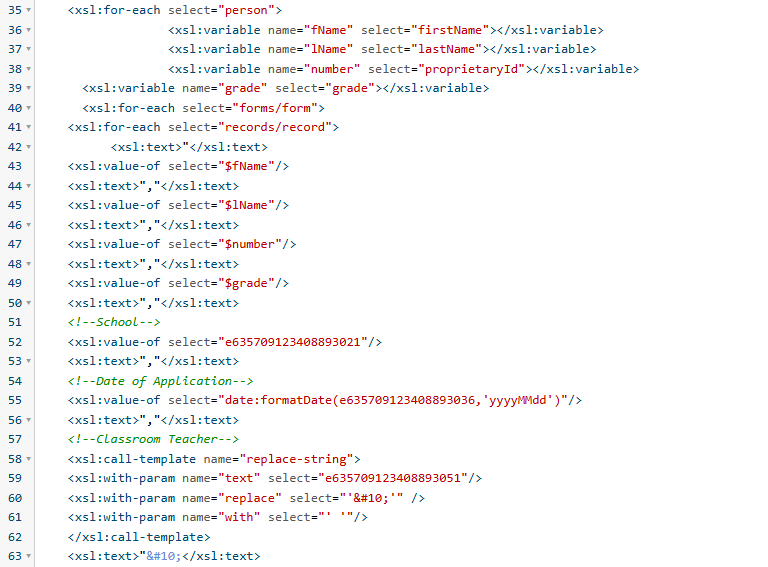Creating a CSV Export
Developing the export definition uses XSLT 1.0 as a processor to generate the text out.
As
you are developing, we encourage you to frequently preview the result
to understand how your code is working. The source of the preview data
is displayed in the "Data Source" panel, as described in Step 6. This
data source is populated with the most recent updated 25 records that
you also have access to.
We
have included a custom function that you can use to help with data
formatting. Certain formats such as CSV and JSON require some characters
to be handled differently. This can include quotes and commas. The
function is called str:sanitize(), and an example of using it is:
<xsl:value-of select="str:sanitize('e123456789')"/>
CSV Exports require a "Header" section for the data to be sorted in the correct column.
For example:

is the HTML entity for a line break. This is required to let the export module know where the header ends.
The following is the data associated with each column header. The example uses a variety of techniques to get the correct value. <xsl:for-each select="person"> loops through every person in the data set and retrieves their first name, last name, proprietary ID, and grade. To begin, an opening statement of:  is required. This informs the export module that the data portion is beginning.
is required. This informs the export module that the data portion is beginning.

To call a variable it is required to prepend "$" to the variable name; i.e.: <xsl:value-of select="$fName"/>.
To end the CSV Export the following is required:  .
.

Additional Resources
XSLT Data Conversion Transform XML to CSV and JSON: https://piembsystech.com/xslt-data-conversion-transform-xml-to-csv-and-json/
How to Use EXSLT: https://exslt.github.io/howto.html
XSLT: Creating New XML/CSV Structure for Transformed Data: https://www.trycatchdebug.net/news/1389321/xslt-transformation-for-xml-csv-structures
Related Articles
Creating a JSON Export
Developing the export definition uses XSLT 1.0 as a processor to generate the text out. As you are developing, we encourage you to frequently preview the result to understand how your code is working. The source of the preview data is displayed in ...Creating an XML Export
Building using a Preset (XML Only) If you do no have specific format requirements, or would like to see examples of how to develop using XSLT 1.0, you can use our "Presets" feature. To use a Preset, click on the button in the Action Bar. Using the ...XSLT Basic Syntax
XSLT 1.0 is a declarative programming language designed to transform XML documents into other formats, such as XML, HTML, CSV, or JSON. Its template-driven approach allows developers to define how data should be reorganized. On the Clevr platform, ...Export Module - Generating Presets Definitions
Currently, the ability to generate presets is available only for XML Format exports, with plans to expand support for CSV and JSON formats in the future. Presets are designed to streamline the export process by allowing users to configure settings ...Data Export Module - Resources List
To help you get started and make the most of the Export Module, we offer a comprehensive set of resources. These articles cover everything from basic setup to advanced usage, ensuring that users of all experience levels can benefit from the module's ...